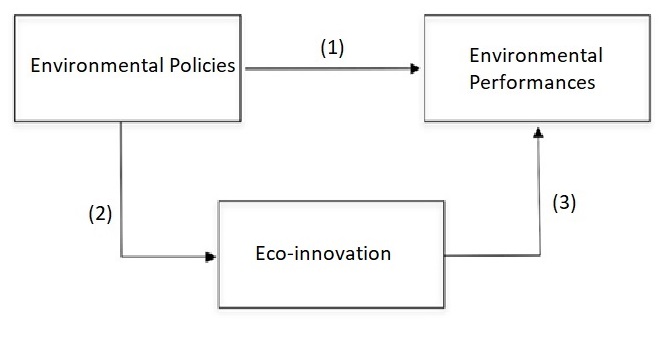Green technologies and environmental policies for sustainable development: Testing direct and indirect impacts
D’Amato A., Mazzanti M., Nicolli F., 2021 – Journal of Cleaner Production
Eco-innovation plays a crucial role in promoting environmental sustainability of production and consumption behaviours. This is clear, for example, from the ambitious goals set by the European Green Deal, especially in relation to the transition to a circular and sustainable economy and to the achievement of the transition to net-zero CO2 emissions (see https://www.eea.europa.eu/en/analysis/indicators/eco-innovation-index-8th-eap). The goals of the European Green Deal imply that eco-innovation efforts are expected to keep increasing. On the other hand, the heterogeneity in performance among countries and sectors within the European Union and the need to accelerate the transition require changes in intervention policies, suggesting the need to engage in the empirical analysis of the potential effects of such policies (see https://oecdecoscope.blog/2023/09/06/accelerating-the-eus-green-transition/).
The reduction of the environmental impact of economic activities generated by more stringent environmental policies can occur both directly, through an increase in the opportunity cost of harmful behaviours (e.g., CO2 emissions or other types of pollutants), and indirectly through the virtuous effect that more stringent policies can generate in terms of incentives towards “green” innovation and, as a result, on environmental impacts.
Starting from these considerations, in the article “Green technologies and environmental policies for sustainable development: Testing direct and indirect impacts” published in Journal of Cleaner Production, Alessio D’Amato, Massimiliano Mazzanti, and Francesco Nicolli focus on the outlined empirical analysis, relying on the conceptual framework represented in Figure 1.

Figure 1 highlights two ways in which environmental quality can be affected by policies:
1. A direct effect (1), according to which more stringent environmental policies improve environmental performances through changes in the relative cost borne by firms or consumers generating negative environmental impacts and/or through limits or bans related to such impacts.
2. An indirect effect, conveyed by the promotion of innovation driven by more stringent environmental policies (2) and by the impact that “green” innovations have on environmental performance, for example through the reduction of pollution abatement costs resulting from eco-innovation (3).
The study uses a dataset including observations for 25 European countries over the period 1990-2015 (mainly based on OECD data). Four different dependent variables measuring various dimensions of environmental quality (or performance) are used: Value Added (VA) per unit of SO2, VA per unit of N2O, VA per unit of CO2, and waste recycling rate. The first three variables account for performances related to climate change and air pollution, while the last one can be seen as a proxy for the transition to a circular economy. These variables are used to understand how the stringency of environmental policy and efforts in terms of eco-innovation can influence environmental performances (indicated by arrows labelled as (1) and (3) in Figure 1). Additionally, the study estimates the effect that environmental policy has on innovation, represented by arrow number (2) in Figure 1. The indirect impact of environmental policy on environmental performances, through the impact on eco-innovation, is thus obtained as a combination of impacts (2) and (3) in Figure 1.
The main variables used to assess these relationships are as follows:
– For the relationship between technology and environmental quality, the study examines the link between the stock of relevant patents for each category of environmental performance and the corresponding level of performance.
– For the relationship between environmental policy and eco-innovation, the study explores the link between the stringency of environmental policy and the eco-innovation effort, as measured by the flow of relevant patents.
– The stringency of environmental policy is measured by constructing a variable that considers policies of various types adopted in each country each year and relevant to each specific measure of environmental performance considered in the study, based on OECD data (https://pinedatabase.oecd.org/). Environmental policies are aggregated at the country level and “weighted” on the basis of their stringency.
To assess impacts (1) and (3) in Figure 1, the study adopts a fixed-effects panel model and estimates four different equations, one for each environmental performance measure; in each equation, performance is the dependent variable, while the main independent variables are intervention policies and relevant patent stocks. The obtained results are coherent with existing literature, showing that more stringent environmental policies are correlated with better environmental performances in the four dimensions considered (effect (1) in Figure 1). At the same time, the estimates show a positive relationship between the patent stock and each dimension of environmental performance (relationship (3) in Figure 1). This suggests the possibility of an indirect impact of environmental policy, by improving environmental performances through innovation.
For this effect to happen, however, innovation must be positively correlated with selected environmental policy measures. This link is confirmed according to a second relationship estimated in the study (relationship (2) in Figure 1): with reference to each of the four investigated dimensions of environmental performance, the study shows a positive and statistically significant link between intervention policies and the flow of relevant patents. These results are robust to a number of tests.
The study highlights the role that environmental policies can play indirectly through their impact on innovation. The obtained results can therefore be of help in the design of environmental policy, also considering the potential need to implement complementary innovation policies.

